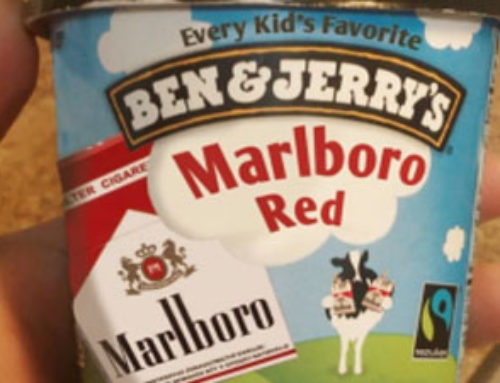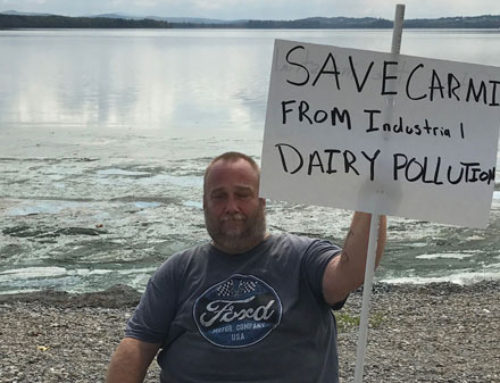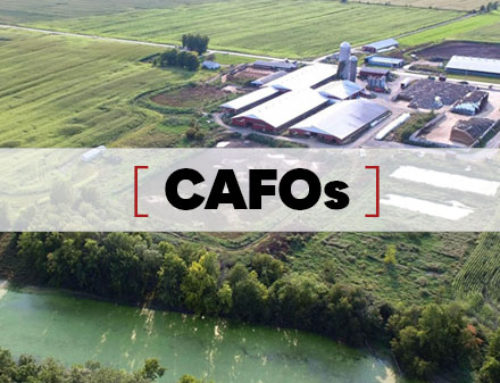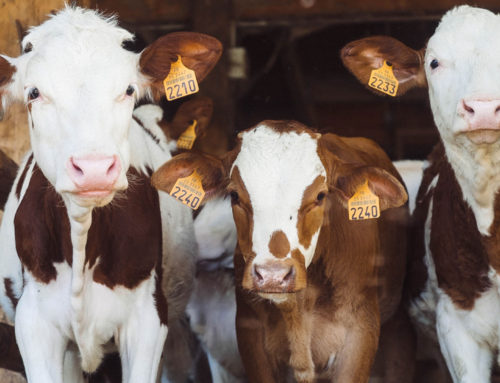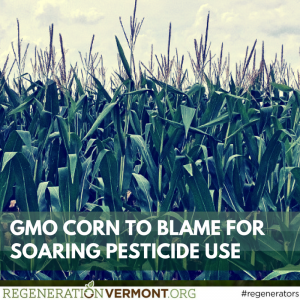 Ending its three-year stall on publishing statewide pesticide usage data, Vermont’s Agency of Agriculture, Food and Markets finally released the information in January in response to a public records request. The newly released data covers the years 2014-2016, and it shows a dramatic increase in pesticide use on Vermont’s dairy farms, particularly when it comes to managing GMO cornfields. The use of glyphosate, for example, more than doubled in those three years, while overall corn-related pesticide use rose 27 percent.
Ending its three-year stall on publishing statewide pesticide usage data, Vermont’s Agency of Agriculture, Food and Markets finally released the information in January in response to a public records request. The newly released data covers the years 2014-2016, and it shows a dramatic increase in pesticide use on Vermont’s dairy farms, particularly when it comes to managing GMO cornfields. The use of glyphosate, for example, more than doubled in those three years, while overall corn-related pesticide use rose 27 percent.
GMO corn is now grown on more than 92,000 acres in Vermont, making it – by far – the state’s number one crop. And all of it is being grown for the state’s 135,000 cows, mostly now confined as the large, mega-dairy model increasingly takes over, seen most dramatically in Franklin and Addison counties, where “farms” are now warehousing thousands of cows.
In 2016, Vermont’s GMO corn crops received a 194,631 pound bathing of pesticides, a toxic stew that included 34 different products, everything from atrazine to 2,4-D. This was up from the 142,604 pounds used in 2014, a 27 percent increase in the three years. The most heavily used cornfield pesticide in 2016 was glyphosate, with 62,458 pounds used, more than doubling the 27,440 pounds used in 2014.
According to Cary Giguere, Agrichemical Program manager at the agriculture agency, the dramatic rise in glyphosate use was a result of increased cover cropping on cornfields, where herbicides like glyphosate are used for what they call the “burn-down,” or killing of the cover crop,” before corn planting begins in the spring.
Unfortunately, it’s another example of good intentions gone awry. Given the growing water quality problems in heavily corn-cropped regions like Franklin and Addison counties, state and federal regulators are pushing – even requiring — cover crops to be grown to remediate runoff and carbon release during the fallow months. That’s a good thing. But not when it comes with a directive – and even a subsidy in many cases – to use toxic herbicides on those same vulnerable fields for a chemical burn-down.
The problem is the GMO corn. Vermont grows too much of it, demonstrating its reliance on a confinement model that has replaced grazing. Instead of grass, the modern dairy cow is literally gorged with a rich, corn-based diet, all to maximize production. And it’s working, as today’s cow produces three times what a similar cow produced in the 1970s, even though overproduction of milk remains the industry’s biggest problem. But it’s also taking its toll, as the industrial-dairy cow is now barely living to the age of 5 before being shipped off to the meat supply.
But the dominating dairy model – confined, concentrated and chemical/GMO-intensive – is dictating Vermont’s agricultural dilemma, and has been for generations, a long, long way from its prime. Worse, it’s a model that is wholeheartedly embraced and defended by our agricultural agencies, at all levels, making them the quintessential captive agencies, defined by the subservience displayed toward the ones they’re supposed to be regulating.
Take, for example, the Vermont Agency of Agriculture’s response to the dramatic rise in statewide pesticide usage: [Insert silence]. Worse, they don’t have a plan for how to meet even their most basic statutory requirements, reviewing new chemicals or releasing pesticide usage data in a timely manner, for example.
“It’s just as frustrating for me,” said Giguere, in an interview about the new data. “It’s a resource issue. I don’t have the staff. I don’t have the resources.”
Last November, Giguere appeared before the Lake Champlain Basin Project’s Citizen Advisory Committee to answer questions about pesticides and water contamination. According to the committee minutes of the meeting, there was concern raised about the daunting tasks facing Giguere’s pesticide division, given the need for more reviews, guidance, and oversight. When asked about the staffing and resource status of his pesticide regulatory division, here was Giguere’s response: “The legislature’s and governor’s current priority is water quality. We’ve reduced staffing in the pesticide program to have a more robust water quality program.”
But there is an impaneled council established in 1970 to address pesticide usage in the state, the Vermont Pesticide Advisory Council. According to Vermont statute (Title 6, Chapter 87, section 1102), the council serves under the agriculture agency and is charged with reviewing overall pesticide use, policy and regulation in the state, and to make recommendations for “reducing the amount of acreage where pesticides are used” and “reducing the risks associated with the use of pesticides.”
Giguere is the Pesticide Advisory Council’s appointed member from the agriculture agency, which might explain another thing the two entities share: Silence on the growing pesticide threat. While the advisory council has never been a friend to the environmental community, ruling time after time – despite its mission to reduce use and protect the public – in favor of farms, utilities, road crews, railroads and golf course operators who want to spray to kill, one would expect some concern from them about the rise in pesticide use. But, so far, nothing but silence, while it, too, seems to be feeling the staff and resource squeeze now that “water is the focus.” Three council member positions are vacant, including one reserved for the UVM College of Medicine, and both positions reserved for “public advocates,” all awaiting appointment decisions from Gov. Phil Scott.
But Giguere’s pesticide division found the staff and resources necessary to revise and distribute its “fact sheet” on glyphosate. Unveiled at the November Citizen Advisory Committee meeting, just a month before releasing data that would show a more than doubling of its use, the agriculture agency’s glyphosate fact sheet reads like it’s straight out of the chemical maker’s mouth, which, in this case, is Monsanto.
The fact sheet could be summarized in three words: Safer than salt. And it really does make a safety comparison to salt, just like Monsanto did in 1996 when it got the attention of New York state’s attorney general, who sued the corporation for false and misleading advertising over this, and other, fraudulent safety claims. And Monsanto agreed to never use its “safer than salt” claim again in its advertising in New York. But now, 22 years later, Vermont’s top pesticide regulator is dusting off the discredited claim to calm the Vermont public as glyphosate use skyrockets. But Giguere insists that the timing is a coincidence.
The salt claim is, of course, absurd. But it’s frequently trotted out by apologists – frequently regulators – for chemically intensive agriculture. The claim is based on what is called an LD50 test, which is an acute toxicity test that seeks to determine how much of a compound is needed to basically kill a person. Smoking is deemed safer than salt in this kind of test, too, because you’ll die from a lung full of salt but not from a lung full of smoke – in the moment.
But pesticides, like smoking, are threatening based on their chronic toxicity, the long-term, low-dose cellular insults that can trigger mutations and cancers.
Unlike salt, glyphosate has been classified as a “probable carcinogen to humans” by the International Agency on the Research for Cancer, a division of the World Health Organization. Similarly, the California EPA now identifies glyphosate as a cancer-causing chemical and, as such, will require all glyphosate-containing products to contain a cancer warning, as prescribed by its Proposition 65.
In addition to the cancer threats, new science is warning that even the smallest detectable amounts of glyphosate residues can have serious health consequences, including liver and kidney damage. Glyphosate is also suspected of being an endocrine disruptor at very low doses. Its ubiquitous use has resulted in its residues turning up in everything from Cheerios to Doritos, and Oreos to Ben & Jerry’s ice cream.
And glyphosate is just one of the 34 pesticides being applied to Vermont’s annual corn crops, many of which are carcinogenic, mutagenic and/or endocrine disrupting. Making a return visit to this chemical lineup is the infamous 2,4-D, the active ingredient in Agent Orange used by the U.S. military in Vietnam as a defoliant in battle areas and to burn-down Vietnamese farms and gardens. It made its Vietnam debut in a formulation called Agent Purple in 1962, then it went on to become the key ingredient in Agent Orange in 1965. In 2016, there were 5,361 pounds of 2,4-D sprayed on Vermont’s cornfields, up from just 418 pounds in 2014. The reason is that weeds are developing a resistance to the heavily used glyphosate, so other herbicides like 2,4-D, Dicamba, and atrazine are being called in for duty.
It is tragically ironic that at a time when pesticide use is rising, the Vermont Agency of Agriculture is turning its regulatory resources away from pesticide protection and toward water protection – as if they aren’t intricately connected. But it’s yet another clear signal that our political and regulatory leaders are standing in the way of the public’s increasing call to address the failed dairy model that connects not just pesticide and water issues, but also labor, economic, animal welfare, and climate issues.
“Vermont’s environment is subsidizing our failed dairy model,” is how Rep. David Deen so succinctly explained it at a recent panel discussion on water policy. And he ought to know, having seen the damage from industrial dairies from his perch as the chairman of the Fish, Wildlife & Water Resources Committee.
The agriculture agency doesn’t have to choose between focusing on pesticide contamination or water quality. They can – and should – be doing both. And it must start with putting the interests of the people and our natural relationships before the interests of the corporate monopolies dictating a dairy model that exploits farmers, laborers, animals, water, and land.
Vermont Agency of Agriculture, Food and Markets reports
